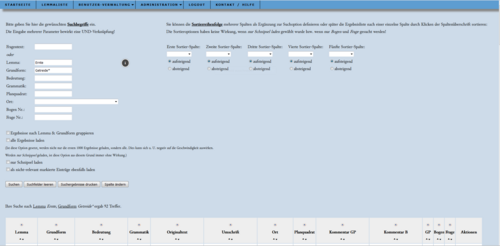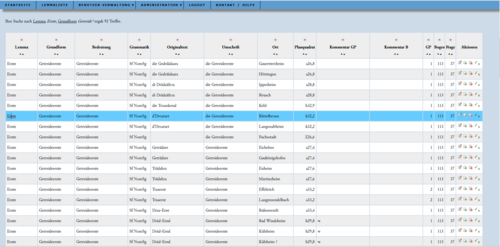Deciding to go digital, the Franconian Dictionary is embarking on new paths within dialectal lexicography. All dialect examples are recorded in a full text data base system as well as grammatically and semantically defined, resulting in a dictionary that replaces tedious and lengthy research in the editorial office’s archive. It also makes the documents available to the scientific as well as the non-scientific public. The Franconian Online Dictionary can already be accessed by the public, even while it is still in the making. Parallel to the ongoing data recording and editing process the online dictionary will expand step by step.
Everybody can access the data base of the Franconian Online Dictionary. Just send a short e-mail to fraenkisches-woerterbuch(at)fau.de, you will receive an answer with your personal access code.
While this process is still going on, first assessments can already be made considering comprehensive aspects. The resulting data already serve colleagues at the University of Erlangen-Nuremberg as a reliable base for scientific research work in various fields.
In 2012 a major part of this inventory was scanned and archived as image files, a measure taken to back up the original documents and largely funded by the Franconian regional districts.
Content and Functions of the Franconian Online Dictionary Database
Currently the database comprises about 800.000 usage examples of individual words or word forms. It covers the complete alphabet, containing words starting with the letters A to Z, that is. The homepage (figure 1) offers a number of input fields.
Various types of search terms are offered for the user to enter (on the left in vertical order). There are also sorting criteria to be chosen from a list (on the right in horizontal order). Search terms and sorting criteria refer to the columns of a table displaying the results.
Each line represents an example of the word in original documents. The individual column informs on the documented words, i.e. words found in written sources.
Description of individual columns
Column | Description |
|---|---|
Stamm | Shows the word’s root or roots , in our example Getreideernte this would be the basic word Ernte. The same example pops up at another place in another line, this time for the lexeme Getreide. Reason for the double entry is to offer the possibility of composing all words resulting from a searching the elements Getreide or Ernte. |
Grundform | The column „Originaltext“ shows the word in a spelling most closely adapted to the standard German language, shown in the grammatical „nominal form“. With nouns this is e.g. the nominative singular, with verbs the infinitive. This form basically represents the keyword in traditional printed dictionaries. |
Bedeutung | Shows the shortest and most precise paraphrase possible of the given word’s basic or nominal form. |
Grammatik | Showing in abbreviation the part of speech followed after a blank by the inflexion form. In the case of Getreideernte this is a noun ( S for “Substantiv”) , genus feminine (f). In context it is used in the nominative (see column Originaltext Nom Sg). |
Originaltext | Showing the complete text according to a closely reproduced true-to-original answer given by a reference person. It also takes into account punctuation marks like macrons above vowels in order to show its spoken length. |
Umschrift | The complete original text (often a complete sentence) represented in a close to standard spelling. |
Ort | Showing the name of a village or city the vernacular of which the example refers to. |
Planquadrat | Showing the example’s origin. The outlines given refer to a map showing all of the German-speaking area along latitudes and longitudes in grid squares of about 70 square kilometres. The letter refers to the vertical axis (north-south), the number to the longitudinal axis (east-west). The number after the comma refines the positioning by subdividing the grid square into nine smaller squares with eight square kilometres each. In a later version the traditional coordinates will be complemented by corresponding geo reference data. |
Kommentar GP | Showing, where appropriate, additional remarks by the answering reference person, partially referring to content-related specifications of the example, e.g. „nur für Roggen, Weizen und Gerste, nicht für Hafer“ or referring to a restriction with regard to the word’s fluency, e.g. „sagen nur die Jungen, sonst hieß es Kornernte“. |
Kommentar Bearbeiter | Showing comments referring to the example’s validity like „schlecht leserlich“ or „Wortart nicht sicher“, but also cross-references to other dictionaries informing on the etymology or dissemination of the example word. |
GP | Showing a consecutive number always greater than 1 , if there have been several questionnaires of the same survey sent to the editorial office from the identical grid square. |
Bogen | Showing the questionnaires serial number where the answer has been entered. 123 different questionnaires have been sent, with 200 to 1200 copies each. |
Frage | Showing the number of the question posed in a given questionnaire. There were between 30 and 60 questions asked. |
Aktionen | This last column on the very right contains entry elements only. A click on the symbol „Stift und Papier“ will show a picture of the original example. Theses images show the section of the questionnaire where the example was entered. It also shows the question’s text, complementing information in the column „Bedeutung“, allowing conclusions as to the semantics of an answer. Elements „+“, „x“ and the green check are available only to the dictionary editors. Element „S“ informs about the social data of the reference person answering. |
How to Use the Database
The Online Dictionary allows numerous search opportunities. Below we describe three of them.
1. Search for a vernacular word with spelling unknown
Granted that the user knows a word sounding something like "Katerruh". He or she remembers it being used for the free spot in a game of catch. The easiest way is to search in the column „Grundform“. On the start page the user enters the character string "Katerruhe". He gets no result but the answer „Ihre Suche nach Grundform Katerruhe ergab leider keine Treffer“. Obviously the database doesn’t know a nominal form SPELT this way. Since the user knows that the word is somehow related to the game of catch, he may start a second try by entering the word "Fangenspiel" in the search field „Bedeutung“, leaving the column „Grundform“ empty. The result is a long list of words dealing with the game of catch. Scrolling the results he may find some with the "lemma Ruhe", among them maybe some with the basic form "Gute Ruhe" or "Katzenruhe". Among them there are also some with the original text of "Guda Ruh", "Guttäru" or "Katzaruh". Obviusly "Katerruh" belongs here and represents just another version of "Gute Ruhe", originally referring to a place where rest is allowed („Platz, an dem es erlaubt ist, sich auszuruhen“).
2. Search for vernacular words with a specific word formation structure
Compilations of this kind usually are needed by expert colleagues. Typical for the Franconian dialect are derivatives of collective nouns with the ending -ig. Very rarely there are found in in written German like in" Reisig". The Franconian knows many of these structures, e. g. Erdäpfelkräutig „Kartoffelkraut“, "Bützig", „Küchenabfälle, die beim Zubereiten von Gemüse entstehen“, "Gschmarrig, unsinniges Gerede“…
Entering the character string *ig" will search for all examples for words ending on -ig. Which will result in showing also many adjectives ("fertig", "haarig", "zeitig"…). This can be avoided by entering an additional search criteria in the column „Grammatik“ with the letters Sn. This reduces the search to nouns with a neutral genus.
3. Search for vernacular words from a specific village
Frequently there are efforts in some Franconian villages to document their very own vernacular in a dictionary of their own. The material needed can be made available via database by entering the name of the village in the search field. To do so, it is recommended to use the „Grundform“. This way users achieve a base for their local dictionary from which they can choose and which they can complement with their own material.


